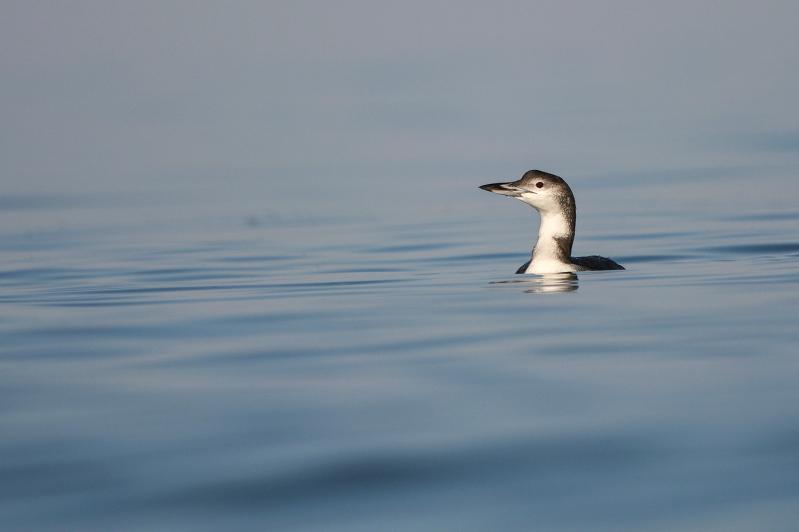It’s midsummer in the year 2000 and I’m floating on a boat in Lake Winnipesaukee. The boat is owned by a college friend and co-worker. It’s nighttime and the engine is off. We’re just drifting and looking at the stars. A sound, byzantine, mysterious, and surprising, breaks the quiet: a common loon. I wasn’t into birds then, but still remember that first encounter.
Fast-forward a few years and my friend has stolen $50,000 from me. It’s 2008, and I’m reading “One Morning in Maine” by Robert McCloskey to my 4-year-old daughter. The protagonist, a 10-year-old girl named Sal, slips on some seaweed. A loon, idling a few feet from the rocky shore, laughs at her.
“Luh-hoo-hoo-hoo-hoo-hooh!” is how McCloskey describes the call.
Here we are in 2023. I haven’t heard from the friend in 15 years, so I’ve given up on the $50,000, and my daughter is in college. Last week, middle-aged me stared out into the gray bayscape at Long Wharf in Sag Harbor and watched eight loons scattered inside the breakwater dive.
One emerged, so close that beads of water were visible rolling from its back as it wrestled some unidentifiable fish as large as its head. The fish had no shot, of course. The loon’s mouth and tongue have inward facing barbs that had it trapped. The thrashing was pure theater.
After breeding on the northern lakes, loons arrive on the East End in the autumn and increase in numbers through the winter as their breeding territories freeze. They’re generally alone, a contrast to the tight groups of long-tailed ducks, red-breasted mergansers, and scoters that share their winter habitat. They’re also much larger, larger even than a great black-backed gull. Compared to the zippy bay ducks, they seem slow and lethargic.
Out on the water, they appear as large, dark-gray blobs. A closer look shows their thick necks are white in front. Mid-neck, some gray seeps in from the back, breaking the clean divide. Their heads are blocky and squarish and their bills, about as long as their heads, are chunky and bluish gray.
Why do they winter in our cold bays? “What they’re trying to do is survive,” said Charles Walcott, former director of the Cornell Lab of Ornithology. “If you eat only fish, it’s awful hard when the ponds up north freeze over. What you do is go down to saltwater and do the best you can.”
In the winter of 1984, the North Fork Audubon Society counted 2,000 in Gardiner’s Bay. Last year, I counted 20 swimming off Camp Hero, in Montauk, where they also love the Lake Montauk Inlet. During Thanksgiving week, Evan Schumann, an East Hampton birder, counted 13 at Fresh Pond preserve in Amagansett. Every day, there’s at least a handful off Long Wharf. On a windless day especially, they’re easy to find.
Before the loon dives, it will often peer underwater as it swims, in search of a target fish. When it finds one, it descends, propelled solely by its feet, which are placed far back on its body, in contrast to the bay ducks, which also use their wings underwater, like flippers. When mating, according to allaboutbirds.org, “Loon parents and their two chicks can eat about a half-ton of fish over a 15-week period.”
Mr. Walcott said the birds can survive our winter water because they’re “well insulated, with a substantial layer of feathers. As long as they get a reasonable amount of food, they’re fine. They generate a lot of heat, maintaining a body temperature higher than ours, of about 100 degrees.”
He was interested in studying the vocalization of the loon. Their yodel, he said, was territorial and translated loosely to, “If you come here, I will dive below you and try to spear you with my beak.” Every male’s yodel differs slightly but is consistent and tied to its territory. If they change territory, they change their yodel. “It’s very important to a loon to be different,” he said.
“They’re such a symbol of northern wilderness. When you hear them on lakes in the evening and early morning, it gives you a feel of the place. They’re charismatic in that way, but they’ve been having a rough time of it. A lot have been killed by oil spills, particularly north of Cape Cod. The thing to emphasize is that they regard Long Island as south, as opposed to Florida. People should be grateful for their presence.”
They vocalize much less in the winter, but last week I was definitely grateful, and surprised, to hear them doing yodel fragments off the wharf. Wait for a windless sunrise when the bay is calm. Maybe you hear the song, maybe not.
Edward Howe Forbush, in the 1905 collection “Birds of America,” wrote, “Of all the wild creatures which still persist in the land, despite settlement and civilization, the Loon seems best to typify the untamed savagery of the wilderness.” And perhaps now, as we descend into winter and our area gets relatively quiet, there is no better time to observe this bird. Try to just watch it and imagine the savage wilderness, despite everything.

